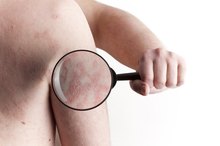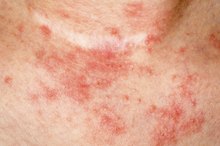How to Reduce Keratin
Keratin is a key protein found in skin. The over-production of keratin is a condition called keratosis pilaris. For many, the breakouts resemble acne. The mechanisms of the two illnesses are similar and result in plugged follicles. However, keratosis pilaris may form in groups or patches that appear as dry scaly skin with small red or white bumps. The cause of this condition is unknown, but it may be genetic. Keratosis pilaris may have an association with genetic diseases or skin problems, such as atopic dermatitis. Treating the symptoms of the illness may be the only way to control it. Skin constantly regenerates and it needs keratin for that process, but good skin care can reduce the buildup of keratin on the skin surface.
- Keratin is a key protein found in skin.
- Skin constantly regenerates and it needs keratin for that process, but good skin care can reduce the buildup of keratin on the skin surface.
Wash the affected area daily, but avoid over washing. Once or twice a day is enough. Do not scrub your skin; instead, apply a mild cleanser to the area and rub skin with your fingertips or a soft cloth to help exfoliate. Rinse the area to remove dirt and debris.
Red Itchy Skin Around the Nose
Learn More
Moisturize the skin while it is still wet using lotions with urea or propylene glycol.
Set up a humidifier in your bedroom to increase your exposure to moisture. This will help elevate some of the dry patches.
- Wash the affected area daily, but avoid over washing.
- Set up a humidifier in your bedroom to increase your exposure to moisture.
What Is the Difference Between Cellulitis & Mrsa?
Learn More
Apply an over-the-counter medication containing lactic acid. Topical lactic acid removes excess keratin.
Tips
On her website, Dr. Donnica Moore recomends constant skin care to help reduce the incidence of breakouts and to manage the build-up of keratin. A daily care regimen may help control the illness. Keratosis pilaris is not a serious medical condition and usually responds well to skin care and moisturizing.
Warnings
Skin that is painful, swollen or itchy needs medical evaluation. There are a number of conditions that can cause similar symptoms. Some, such as eczema, may require medical treatment. Open areas on the skin can lead to infections and sepsis. If the bumps have drainage, develop red streaks or fail to respond to daily skin care, seek professional help. Medications such as topical corticosteroids or retinoids may help reduce irritation so skin can heal.
Related Articles
References
- Dr. Donnica.com: White Bumps That Aren't Acne
- National Institutes of Health: Keratosis Pilaris
- Thomas M, Khopkar US. Keratosis pilaris revisited: Is it more than just a follicular keratosis?. Int J Trichology. 2012;4(4):255-8. doi:10.4103/0974-7753.111215
- Wang JF, Orlow SJ. Keratosis pilaris and its subtypes: Associations, new molecular and pharmacologic etiologies, and therapeutic options. Am J Clin Dermatol. 2018;19(5):733-57. doi:10.1007/s40257-018-0368-3
- Gruber R, Sugarman JL, Crumrine D, et al. Sebaceous gland, hair shaft, and epidermal barrier abnormalities in keratosis pilaris with and without filaggrin deficiency. Am J Pathol. 2015;185(4):1012-21. doi:10.1016/j.ajpath.2014.12.012
- Liu F, Yang Y, Zheng Y, Liang YH, Zeng K. Mutation and expression of ABCA12 in keratosis pilaris and nevus comedonicus. Mol Med Rep. 2018;18(3):3153-8. doi:10.3892/mmr.2018.9342
- Pennycook K, McCready T. Keratosis pilaris. In: StatPearls. Updated September 13, 2019.
- Sonthalia S, Bhatia J, Thomas M. Dermoscopy of keratosis pilaris. Indian Dermatol Online J. 2019;10(5):613-4. doi:10.4103/idoj.IDOJ_279_18
- Peter Rout D, Nair A, Gupta A, Kumar P. Epidermolytic hyperkeratosis: clinical update. Clin Cosmet Investig Dermatol. 2019;12:333-44. doi:10.2147/CCID.S166849
- Kootiratrakarn T, Kampirapap K, Chunhasewee C. Epidermal permeability barrier in the treatment of keratosis pilaris. Dermatol Res Pract. 2015;2015:205012. doi:10.1155/2015/205012
- Schwitulla J, Brasch J, Löffler H, Schnuch A, Geier J, Uter W. Skin irritability to sodium lauryl sulfate is associated with increased positive patch test reactions. Br J Dermatol. 2014;171(1):115-23. doi:10.1111/bjd.12893
- Ciliberto H, Farshidi A, Berk D, Bayliss S. Photopneumatic therapy for the treatment of keratosis pilaris. J Drug Dermatol. 2013 Jul;12(7):804-6.
Writer Bio
Writing since 1999, Darla Ferrara is an award-winning author who specializes in health, diet, fitness and computer technology. She has been published in "Mezzo Magazine" and Diet Spotlight, as well as various online magazines. Ferrara studied biology and emergency medical technology at the University of Nebraska and Southeast Community College.








